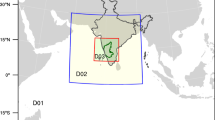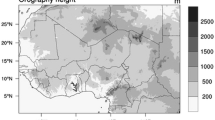Abstract
We investigated the impact of tuning the length scale of the background error covariance in the Weather Research and Forecasting (WRF) three-dimensional variational assimilation (3DVAR) system. In particular, we studied the effect of this parameter on the assimilation of high-resolution surface data for heavy rainfall forecasts associated with mesoscale convective systems over the Korean Peninsula. In the assimilation of high-resolution surface data, the National Meteorological Center method tended to exaggerate the length scale that determined the shape and extent to which observed information spreads out. In this study, we used the difference between observation and background data to tune the length scale in the assimilation of high-resolution surface data. The resulting assimilation clearly showed that the analysis with the tuned length scale was able to reproduce the small-scale features of the ideal field effectively. We also investigated the effect of a double-iteration method with two different length scales, representing large and small-length scales in the WRF-3DVAR. This method reflected the large and small-scale features of observed information in the model fields. The quantitative accuracy of the precipitation forecast using this double iteration with two different length scales for heavy rainfall was high; results were in good agreement with observations in terms of the maximum rainfall amount and equitable threat scores. The improved forecast in the experiment resulted from the development of well-identified mesoscale convective systems by intensified low-level winds and their consequent convergence near the rainfall area.
Similar content being viewed by others
References
Barker, D. M., W. Huang, Y.-R. Guo, A. J. Bourgeois, and Q. Xiao, 2004: A three-dimensional variational (3DVAR) data assimilation system for use with MM5: Implementation and initial results. Mon. Wea. Rev., 132, 897–914.
Chapnik, B., G. Desroziers, F. Rabier, and O. Talagrand, 2004: Properties and first application of an error statistics tuning method in variational assimilation. Quart. J. Roy. Meteor. Soc., 130, 2253–2275.
Cressman, G. P., 1959: An operational objective analysis system. Mon Wea. Rev., 87, 367–374.
Daley, R., 1991: Atmospheric Data Analysis. Cambridge University Press, New York, 457pp.
Desroziers, G., and S. Ivanov, 2001: Diagnosis and adaptive tuning of observation-error parameters in a variational assimilation. Quart. J. Roy. Meteor. Soc., 127, 1422–1452.
Gu, J., Q. Xiao, Y.-H. Kuo, D. M. Barker, J. Xue, and X. Ma, 2005: Assimilation and simulation of Typhoon Rusa (2002) using the WRF system. Adv. Atmos. Sci., 22, 415–427.
Guo, Y.-R., H.-C. Lin, X. X. Ma, X.-Y. Huang, C. T. Terng, and Y.-H. Kuo, 2006: Impact of WRF-Var (3DVar) background error statistics on typhoon analysis and forecast. 7th WRF User’s Workshop, Boulder, Colorado, 19–22 June 2006.
Hayden, C. M., and R. J. Purser, 1995: Recursive filter objective analysis of meteorological fields: Applications to NESDIS operational processing. J. Appl. Meteor., 34, 3–15.
Hollingsworth, A., and P. Lönnberg, 1986: The statistical structure of short-range forecast errors as determined from radiosonde data. Part I: The wind field. Tellus, 38A, 111–136.
Hong, S.-Y., J. Dudhia, and S.-H. Chen, 2004: A revised approach to ice microphysical processer for the bulk parameterization of clouds and precipitation. Mon. Wea. Rev., 132, 103–120.
Ingleby, N. B., 2001: The statistical structure of forecast errors and its representation in the Met Office Global 3-D Variational Data Assimilation scheme. Quart. J. Roy. Meteor. Soc., 127, 209–231.
Kain, J. S., and J. M. Fritsch, 1990: A one-dimensional entraining/detraining plume model and its application in convective parameterization. J. Atmos. Sci., 47, 2748–2802.
Kain, J. S., and J. M. Fritsch, 1993: Convective parameterization for mesoscale models: The Kain-Fritcsh scheme. The Representation of Cumulus Convection in Numerical Models, Meteor. Monogr., No. 24, Amer. Meteor. Soc., 165–170.
Lee, D. K., H. R. Kim, and S. Y. Hong, 1998: Heavy rainfall over Korea during 1980–1990. Korean Journal of the Atmospheric Sciences, 1, 32–50.
Lee, J.-H., H.-H. Lee, Y. C. Choi, H.-W. Kim, and D.-K. Lee, 2010: Radar data assimilation for the simulation of mesoscale convective systems. Adv. Atmos. Sci., 27, 1025–1042, doi: 10.1007/s00376-010-9162-8.
Lee, M. S., D. M. Barker, and Y.-H. Kuo, 2006: Background error statistics using WRF ensemble generated by randomized control variables. Journal of the Korean Meteorological Society, 42(3), 153–167.
Park, S.-G., and D.-K. Lee, 2009: Retrieval of highresolution wind fields over the Southern Korean Peninsula using the Doppler weather radar network. Wea. Forecasting, 24, 87–103.
Parrish, D. F., and J. C. Derber, 1992: The National Meteorological Center’s spectral-interpolation analysis system. Mon. Wea. Rev., 120, 1747–1763.
Purser, R. J., W.-S. Wu, D. F. Parrish, and N. M. Roberts, 2003a: Numerical aspects of the application of recursive filters to variational statistical analysis. Part I: Spatially homogeneous and isotropic Gaussian convariacnes. Mon. Wea. Rev., 131, 1536–1548.
Skamarock, W. C., and Coauthors, 2008: A description of the advanced research WRF version 3. NCAR Tech. Note NCAR/TN-475+STR, 113pp.
Tanguay, M., P. Bartello, and P. Gauthier, 1995: Fourdimensional data assimilation with a wide range of scales. Tellus, 47A, 974–997.
Thépaut, J.-N., and P. Courtier, 1991: Four-dimensional data assimilation using the adjoint of a multilevel primitive-equation model. Quart. J. Roy. Meteor. Soc., 117, 1225–1254.
Wu, W.-S., J. Purser, and D. E. Parrish, 2002: Threedimensional variational analysis with spatial inhomogeneous covariances. Mon. Wea. Rev., 130, 2905–2916.
Zhang, F., Y. Weng, J. A. Sippel, Z. Meng, and C. H. Bishop, 2009: Cloud-resolving hurricane initialization and prediction through assimilation of Doppler radar observations with an ensemble Kalman filter. Mon. Wea. Rev., 137, 2105–2125.
Author information
Authors and Affiliations
Corresponding author
Rights and permissions
About this article
Cite this article
Ha, JH., Lee, DK. Effect of length scale tuning of background Error in WRF-3DVAR system on assimilation of high-resolution surface data for heavy rainfall simulation. Adv. Atmos. Sci. 29, 1142–1158 (2012). https://doi.org/10.1007/s00376-012-1183-z
Received:
Revised:
Published:
Issue Date:
DOI: https://doi.org/10.1007/s00376-012-1183-z




